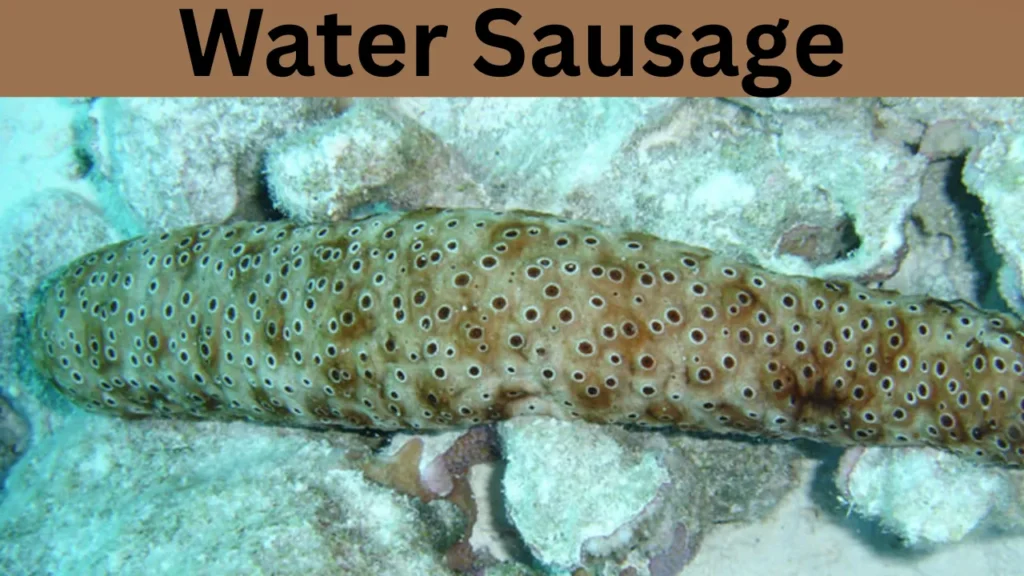The term water sausage might sound funny at first, but it’s a nickname given to one of the ocean’s most helpful and unusual creatures—the sea cucumber. These soft-bodied marine animals are found on the ocean floor, where they slowly move through the sand, cleaning it and helping marine life thrive. Their long, tube-like bodies and squishy texture are what give them their sausage-like appearance. Though they may look simple, this sausages play an important role in maintaining a healthy ocean environment.
Sea cucumbers are not vegetables, despite their name. They are actually animals related to sea urchins and starfish. This sausages are common in oceans all over the world and can live in both shallow and deep waters. While they move slowly and seem defenseless, they have some clever ways to protect themselves, like ejecting their organs to scare off predators and regenerating them later. Their strange yet fascinating behaviors make them one of the ocean’s most interesting residents.
Also Read: cenpok.com
What Is a Water Sausage?
A water sausage is a humorous nickname for the sea cucumber, a soft-bodied marine animal that lives on the ocean floor. Despite the name, it is not a vegetable or an actual sausage, but a living creature closely related to starfish and sea urchins. Sea cucumbers have long, tubular bodies with a leathery skin, which is where the “sausage” comparison comes from. They are found in oceans all around the world and play a crucial role in keeping marine ecosystems healthy. By feeding on decaying organic matter in the sand, this sausages help recycle nutrients and keep the seafloor clean. Their unique shape, texture, and role in nature make them a fascinating and important part of underwater life.
Also Read: Doctorhub360.com Neurological Diseases: Symptoms, Treatment
Physical Characteristics
Sea cucumbers, or water sausages, have elongated, soft bodies without limbs. They possess tiny tube feet that help them move and tentacle-like structures around their mouths to feed. Their skin can vary in color and texture, often adapting to their environment for camouflage. Unlike many sea creatures, it doesn’t have limbs, but it moves slowly using tiny tube feet located on its underside. Around its mouth, the water sausage has several small tentacles that it uses to catch and eat food. Its skin can range in color from brown to orange, green, or even purple, often helping it blend in with its surroundings. Some species have bumpy or spiky textures, while others appear smooth. Despite its simple appearance, the water sausage is uniquely adapted for life on the seafloor.
Also Read: Invest1Now.com Real Estate: Guide to Smart Property Investment
Habitat and Distribution
Water sausages live in oceans all over the world, from shallow coastal waters to the deep sea. They are especially common in the Indo-Pacific region, where warm tropical waters provide an ideal environment. These creatures prefer to stay on the ocean floor, often in sandy or muddy areas where they can feed on organic particles in the sediment. Some species live in coral reefs, while others can survive in colder or deeper parts of the ocean. Their wide distribution shows how adaptable they are to different marine conditions. By living at the bottom of the sea, this sausages help keep the ecosystem balanced and clean.
Also Read: Gomyfinance.com Saving Money: Guide to Financial Freedom
Diet and Feeding Behavior
The diet and feeding behavior of a water sausage are essential to its role in the marine ecosystem. Water sausages feed by consuming sand and mud from the ocean floor, using their mouth tentacles to gather food. Inside the sediment, they extract tiny pieces of decaying plants, animals, and other organic matter. After digesting the nutrients, they expel the cleaned sediment back onto the seafloor. This process not only feeds this sausage but also helps recycle nutrients and keep the ocean environment healthy. Their feeding behavior is slow and steady, but it plays a big part in maintaining a clean and balanced habitat for other sea life.
Reproduction and Lifecycle
Water sausages reproduce both sexually and asexually. In sexual reproduction, male and female water sausages release sperm and eggs into the water, where fertilization takes place. The fertilized egg then develops into a tiny larva, which eventually settles on the seafloor and grows into an adult. Some species can also reproduce asexually by splitting their bodies in half, with each part regenerating into a complete new organism. This ability to regrow missing parts makes them truly remarkable. Their lifecycle helps them survive in different environments and maintain stable populations in the ocean.
Also Read: Apple Sign AppleMiller9to5Mac: Secure Login Meets Trusted News
Defense Mechanisms
When threatened by predators, some species can perform a process called evisceration, where they expel their internal organs out of their body to confuse or scare away the attacker. These organs are later regenerated, showing the water sausage’s strong ability to heal. Some also release sticky, toxic threads that can tangle and harm predators. Their skin may also contain chemicals that make them taste bad or even poisonous to certain animals. These clever defenses help the water sausage survive in a dangerous underwater world, despite its soft and slow-moving body.
Economic and Culinary Importance
The economic and culinary importance of the water sausage is especially strong in parts of Asia, where it is considered a valuable delicacy. In countries like China, Japan, and Korea, dried sea cucumbers are used in soups, stews, and traditional medicine. They are believed to have health benefits such as boosting immunity and improving joint health. Because of this high demand, water sausages are harvested in large numbers, creating a profitable market for fishermen and exporters. However, this has also led to concerns about overfishing and sustainability, as some species are now at risk due to heavy exploitation. Balancing economic gain with environmental care is now a key issue in managing water sausage populations.
Conservation Concerns
In many regions, especially in Asia and the Pacific, water sausages are collected faster than they can reproduce, leading to a sharp decline in their populations. This not only affects the species but also harms the balance of the marine ecosystem, as water sausages play a key role in cleaning and recycling ocean floor nutrients. Some governments and organizations have started protecting them by setting up marine reserves, regulating fishing, and promoting sustainable harvesting practices. Protecting the water sausage is important for both ocean health and future food security.
Interesting Facts
Water sausages, or sea cucumbers, have some truly interesting and surprising traits. One of the most fascinating is their ability to regrow lost organs, which helps them recover after using their defense mechanism of evisceration. Some species even form symbiotic relationships with small fish that live inside their bodies for protection. In traditional medicine, especially in Asia, water sausages are believed to have healing properties and are used in remedies for arthritis and fatigue. Despite their simple appearance, these creatures are full of unique abilities that make them stand out in the animal kingdom and spark curiosity among scientists and nature lovers.
- Regeneration: Water sausages can regenerate lost body parts, including internal organs.
- Symbiotic Relationships: Some fish species live inside sea cucumbers for protection.
- Medicinal Uses: Compounds from sea cucumbers are studied for potential health benefits.
Conclusion
The water sausage, also known as the sea cucumber, is a fascinating marine creature with a soft body and an important role in ocean life. From cleaning the seafloor to supporting marine ecosystems, it does far more than its odd name suggests. Its unique traits—like regeneration, defense mechanisms, and its role in traditional cuisine—make it valuable both ecologically and economically. However, the growing demand for water sausages has led to overfishing and conservation challenges. By learning about and protecting this unusual animal, we can help preserve the balance of our oceans for future generations.



